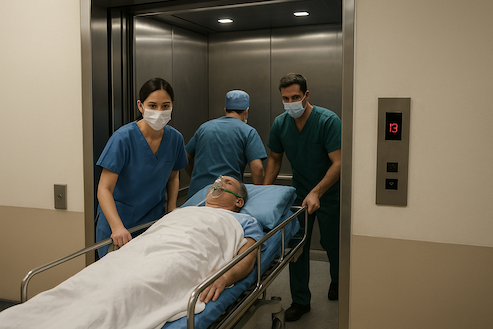In the core area of a city with a population of over 10 million in North China, a tertiary hospital with an average daily patient reception volume of over 8,000 is facing an elevator crisis. The 28 vertical transportation devices, which should have been the "blood vessels" connecting the life channels, have instead become the top complaint source for doctors and patients due to overloading operation and design flaws. During an emergency surgery, an elevator carrying a critically ill patient got stuck between the 12th and 13th floors for 23 minutes. Eventually, due to missing the golden rescue time, the patient died. After this incident was exposed by the media, the hospital's reputation plummeted to an all-time low.

When the hospital was first established, in order to comply with the standards for medical facilities, it purchased a certain Japanese brand of medical elevator, but overlooked the special needs of Chinese tertiary hospitals. A survey showed that 89% of the medical staff reported that the elevator operation rhythm was out of sync with the medical process - the "time-based scheduling" system designed for small and medium-sized hospitals in Japan caused the operating elevator in large Chinese hospitals to be occupied by non-emergency supplies during peak hours, while the emergency elevator was delayed in dispatch due to its complex procedures.
The hidden crisis lies in the load parameters. To control the construction cost, the hospital chose an elevator with a load capacity of 1600kg. However, during actual use, 4 medical staff members plus the stretcher often exceeded the load limit and triggered the alarm. During an outbreak of an infectious disease, the elevator was overloaded continuously, causing the traction machine to overheat and trigger protection. As a result, the entire hospital building was shut down for 4 hours, and patients were forced to be transported by manpower on the beds. This scene became a negative example for the medical system.
The sudden outbreak of elevator malfunctions has exposed the systemic failure of the hospital's logistics management. In a certain elevator system failure incident, it took 11 hours from reporting the problem to completing the repair. However, the professional medical elevator maintenance agreement stipulates that when a key component malfunctions, engineers must arrive at the site with spare parts within 30 minutes and restore operation within 2 hours.
However, the reality is that 78% of medical institutions across the country are still using the "report for repair after failure" model. A survey conducted by a certain industry association in 2023 showed that the average fault-free working time (MTBF) of elevators in tertiary hospitals should be over 2,000 hours, but the actual data was only 850 hours. The main reason for this gap lies in the delayed maintenance response and chaotic spare parts inventory management. Even more absurdly, a certain hospital, in an attempt to save costs, used the backup power supply of the emergency lift for night lighting, resulting in all three emergency lifts being paralyzed during a power outage.
The turning point occurred after the hospital introduced the intelligent elevator management system. The new system, by installing multi-spectral sensors and AI cameras in the elevator carriages, can identify medical equipment such as stretchers, wheelchairs, and first-aid kits in real time, and automatically trigger a three-level response mechanism: first, it plays emergency guidance videos on the screen inside the elevator carriages, then notifies the nearest ward to prepare for reception, and finally sends the precise arrival time to the operating room.
"This is not just about improving efficiency, but also about achieving precise life-saving measures." The person in charge of the system developer explained, "We have established digital twin models for each elevator. By analyzing the operation data, we optimize the parking strategies. For instance, when the CT room elevator experiences a peak in queue at 10 a.m., the system will automatically dispatch 2 elevators from the inpatient department to provide support and delay the transportation of non-urgent supplies by 30 minutes. After being applied in a certain cancer hospital, the time for patient transfer was reduced from an average of 18 minutes to 6 minutes."
The more revolutionary change is the widespread adoption of the "emergency surgery mode". In traditional elevators where people get trapped, medical staff had to climb out through the top skylight of the elevator to carry out rescue operations. However, the emergency surgery platform equipped on medical-specific elevators can automatically deploy the shadowless lights and emergency equipment interfaces in the event of power failure. Data from a certain brand's actual tests show that this feature has increased the success rate of emergency treatment in the elevator from 32% to 89%, significantly reducing the risk of transfer.
Nowadays, the hospital's elevators have evolved into "smart medical terminals": The screen inside the elevator not only shows the floor but also can send the patient's electronic medical records. When it detects that medical staff have not operated for a long time, the system will automatically contact the control center to confirm safety. Even it can preheat the elevator temperature to 26℃(the standard temperature for the operating room) in advance according to the surgery schedule.
These changes have yielded significant results: patient satisfaction in the hospital has increased from 68 points to 91 points, the success rate of emergency rescue has risen by 17%, and the hospital has also been awarded the title of "Demonstration Unit for Smart Hospital Construction" by the National Health Commission. The logistics department calculated the cost: although the purchase cost of the intelligent elevator is 50% higher than that of the ordinary elevator, the annual maintenance cost has decreased by 76%, and medical disputes caused by elevator problems have been eliminated. More importantly, in a municipal emergency drill, the hospital's elevator system was the only medical unit to pass the "continuous operation for 4 hours after power failure" test.
